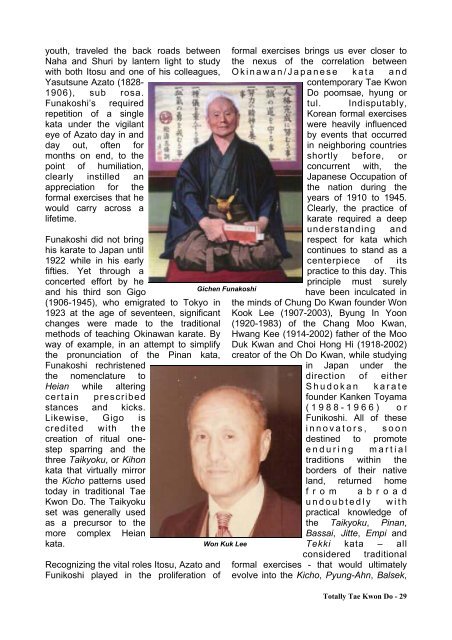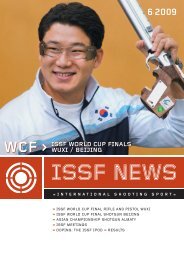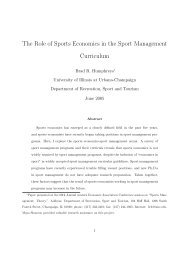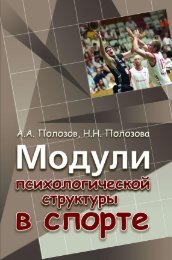You also want an ePaper? Increase the reach of your titles
YUMPU automatically turns print PDFs into web optimized ePapers that Google loves.
youth, traveled the back roads between<br />
Naha and Shuri by lantern light to study<br />
with both Itosu and one of his colleagues,<br />
Yasutsune Azato (1828-<br />
1906), sub rosa.<br />
Funakoshi’s required<br />
repetition of a single<br />
kata under the vigilant<br />
eye of Azato day in and<br />
day out, often for<br />
months on end, to the<br />
point of humiliation,<br />
clearly instilled an<br />
appreciation for the<br />
formal exercises that he<br />
would carry across a<br />
lifetime.<br />
Funakoshi did not bring<br />
his karate to Japan until<br />
1922 while in his early<br />
fifties. Yet through a<br />
concerted effort by he<br />
and his third son Gigo<br />
(1906-1945), who emigrated to Tokyo in<br />
1923 at the age of seventeen, significant<br />
changes were made to the traditional<br />
methods of teaching Okinawan karate. By<br />
way of example, in an attempt to simplify<br />
the pronunciation of the Pinan kata,<br />
Funakoshi rechristened<br />
the nomenclature to<br />
Heian while altering<br />
certain prescribed<br />
stances and kicks.<br />
Likewise, Gigo is<br />
credited with the<br />
creation of ritual onestep<br />
sparring and the<br />
three Taikyoku, or Kihon<br />
kata that virtually mirror<br />
the Kicho patterns used<br />
today in traditional <strong>Tae</strong><br />
<strong>Kwon</strong> <strong>Do</strong>. The Taikyoku<br />
set was generally used<br />
as a precursor to the<br />
more complex Heian<br />
kata.<br />
Recognizing the vital roles Itosu, Azato and<br />
Funikoshi played in the proliferation of<br />
Gichen Funakoshi<br />
Won Kuk Lee<br />
formal exercises brings us ever closer to<br />
the nexus of the correlation between<br />
Okinawan/Japanese kata and<br />
contemporary <strong>Tae</strong> <strong>Kwon</strong><br />
<strong>Do</strong> poomsae, hyung or<br />
tul. Indisputably,<br />
Korean formal exercises<br />
were heavily influenced<br />
by events that occurred<br />
in neighboring countries<br />
shortly before, or<br />
concurrent with, the<br />
Japanese Occupation of<br />
the nation during the<br />
years of 1910 to 1945.<br />
Clearly, the practice of<br />
karate required a deep<br />
understanding and<br />
respect for kata which<br />
continues to stand as a<br />
centerpiece of its<br />
practice to this day. This<br />
principle must surely<br />
have been inculcated in<br />
the minds of Chung <strong>Do</strong> Kwan founder Won<br />
Kook Lee (1907-2003), Byung In Yoon<br />
(1920-1983) of the Chang Moo Kwan,<br />
Hwang Kee (1914-2002) father of the Moo<br />
Duk Kwan and Choi Hong Hi (1918-2002)<br />
creator of the Oh <strong>Do</strong> Kwan, while studying<br />
in Japan under the<br />
direction of either<br />
Shudokan karate<br />
founder Kanken Toyama<br />
(1988-1966) or<br />
Funikoshi. All of these<br />
innovators, soon<br />
destined to promote<br />
enduring martial<br />
traditions within the<br />
borders of their native<br />
land, returned home<br />
from abroad<br />
undoubtedly with<br />
practical knowledge of<br />
the Taikyoku, Pinan,<br />
Bassai, Jitte, Empi and<br />
Tekki kata – all<br />
considered traditional<br />
formal exercises - that would ultimately<br />
evolve into the Kicho, Pyung-Ahn, Balsek,<br />
<strong>Totally</strong> <strong>Tae</strong> <strong>Kwon</strong> <strong>Do</strong> - 29

















